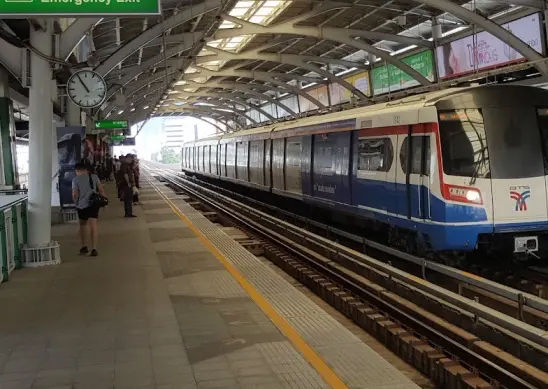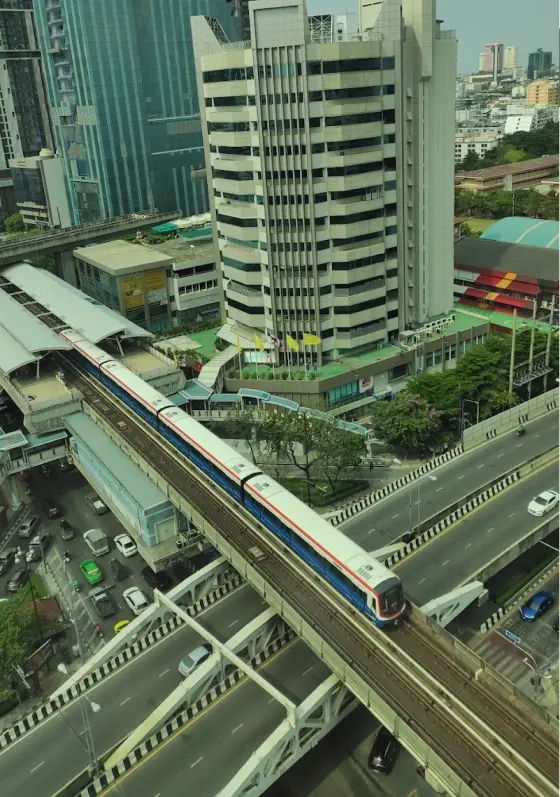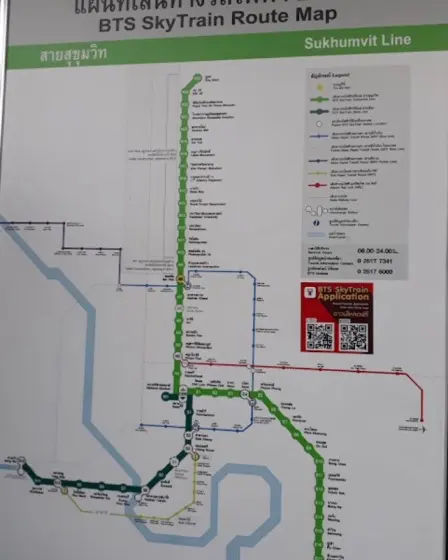Bangkok’s public transportation system includes the BTS and MRT, making it easy to travel around the city. It includes both underground trains and monorail lines that serve the entire Bangkok Metropolitan Region. Currently, the system has two main underground lines—the Blue Line and the Purple Line. In addition, two monorail lines are already running. Overall, the MRT makes getting around Bangkok fast and convenient.
Overview of Bangkok’s Public Transportation System
When you first arrive in Bangkok, you may feel overwhelmed by the traffic, which is slow, packed, and noisy. Bangkok’s BTS and MRT are some of the easiest ways to explore the city.
One of the greatest ways to see the city, from temples to markets, is via this clean, quiet, and affordable subway system. We’ll show you how to use the MRT & BTS, like locals.
- Check out Thailand private luxury tours
Bangkok’s MRT lines
The Bangkok MRT (Mass Rapid Transit) is a modern underground system launched in 2004, and it has become one of the most reliable ways to travel in Bangkok, especially during rush hour when the roads above can come to a standstill.
- Check out Best things to do in Bangkok
| Line | Length & Stations | Route | Train Frequency | Fleet | Service Hours |
|---|---|---|---|---|---|
| Blue Line | 48 km, 38 stations | Loop through central Bangkok (Lak Song, Hua Lamphong, Tao Poon, Bang Sue) | Rush hour: every 3–4 mins Off-peak: every 5–7 mins |
Up to 54 trains | 06:00 a.m. – midnight daily |
| Purple Line | 23 km, 16 stations | Northwest suburbs (Khlong Bang Phai to Tao Poon) | Rush hour: every 6 mins Off-peak: up to every 9 mins |
Up to 21 three-car trains | 05:30 a.m. – midnight (06:00 weekends/holidays) |
BTS vs MRT Skytrain
A common question is the difference between the MRT and the BTS Skytrain. The MRT mostly runs underground, while the BTS runs on elevated tracks. They are two separate systems with different tickets and entrances, but transfer points between them are clearly marked. As for speed, the MRT and BTS are similar, though the MRT often feels faster and more direct in older or more central areas of the city.
Key MRT Stations for Tourists
| Station | Nearby Attractions |
|---|---|
| Tao Poon | Transfer to Purple Line, local neighborhoods |
| Bang Sue | Krung Thep Aphiwat Central Terminal (main train station) |
| Chatuchak Park | Chatuchak Weekend Market, Chatuchak Park |
| Phra Ram 9 | Central Rama 9 Mall, Fortune Town |
| Phetchaburi | Airport Rail Link (Makkasan) |
| Sukhumvit | Terminal 21 Mall, nightlife, BTS Asok connection |
| Lumphini | Lumphini Park, Muay Thai stadiums |
| Sam Yan | Samyan Mitrtown Mall, Chulalongkorn University, Chamchuri Square |
| Hua Lamphong | Bangkok Railway Station, Chinatown, Wat Traimit |
| Wat Mangkon | Chinatown temples, Odeon Circle |
| Sanam Chai | Grand Palace, Wat Pho, Museum Siam, Tha Tien Pier |
| Bang Khun Non | Local temples, riverside walks, quiet neighborhoods |
| Thailand Cultural Centre | Ratchada Train Market, Esplanade Mall |
Bangkok MRT Fares and Ticket Types
No matter which ticket type you use, the Bangkok MRT fare ranges from 16-42 Baht, depending on how far you travel.
1. Single Journey Token
This is a small black coin used for one trip only. You can buy it at a ticket machine or counter inside any MRT station.
- Best for: Tourists or those on a short stay
2. MRT Card (Stored Value Card)
- Adult Card – for everyone
- Student Card – for students under 23 (requires registration)
- Elder Card – for Thai seniors aged 60+
- Initial cost: 180 Baht (includes 100 Baht travel value, 50 Baht deposit and 30 Baht issuing fee)
- Best for: Frequent riders
3. Credit/Debit Card (EMV Tap)
If your Visa or Mastercard has the contactless symbol, you can tap it directly at the MRT gate. This means no need to buy a ticket. But you have to notice that only available at some stations.
- Best for: Tourists with international cards or quick access
4. QR Code Ticket
Buy your ticket using the MRT mobile app or machines with QR options. Scan at the gate to enter.
- Best for: Digital travelers who prefer cashless convenience
A local tip: If you’re staying in Bangkok for a few days and plan to ride the MRT often, getting an MRT Card will save you time.
How to Use Bangkok’s Public Transportation: MRT & BTS
Where to buy tickets?
You can buy tickets at any MRT station, either from:
- Ticket Machines: Touchscreen machines let you select your stop, check the fare, and pay (cash or QR). You’ll get a black token for a single trip.
- Ticket Counters: Staffed counters sell tokens, MRT Cards, and top-up services.
How to Enter and Exit Stations
To enter, tap your token, card, or contactless payment (like a credit card or QR code) on the gate scanner. The gate will open, and walk through quickly.
To exit, do the same at your destination station. If you used a token, drop it into the slot on the gate. Besides, if you used a card or QR, just tap again to exit.
Basic etiquette for riding
- Stand on the left, walk on the right when using escalators.
- Let passengers exit first before you enter the train.
- Keep your voice down since the MRT is usually quiet.
- Offer your seat to monks, the elderly, pregnant women, and people with disabilities.
- No food or drink is allowed on trains or platforms.
- Stay behind the yellow line while waiting on the platform.
Tips for travelers using Bangkok’s MRT & BTS
- 1. Avoid rush hours (7-9 AM, 5-7 PM) if possible, as trains and platforms can get very crowded.
2. Download transport apps like MRT Bangkok, Moovit, or ViaBus to check routes, train times, and station info in real time.
3. Change from MRT to other systems:
- BTS Skytrain: Easy transfers at Sukhumvit (to Asok BTS), Chatuchak Park (to Mo Chit BTS), and Bang Wa (to Bang Wa BTS).
- Airport Rail Link: Connect via Phetchaburi MRT (short walk to Makkasan ARL Station).
- Buses: Most stations have nearby bus stops, check the app for live bus routes.
Wrapping Up: Your Guide to Bangkok’s MRT and BTS
The Bangkok public transportation, the BTS and MRT is one of the easiest ways to explore the city. It’s fast, affordable, and skips the traffic. Whether you’re visiting for a day or a week, it’s a smart, stress-free way to get around.




You May Also Like
Long Coc Tea Hills in Phu Tho: A Hidden Photography Spot Near Hanoi
Long Coc Tea Hills in Phu Tho is a breathtaking hidden gem in northern Vietnam, ...
The Ultimate Guide For Visiting Visit Vietnam In February: Weather, Festivals & Itineraries
Imagine walking through Hanoi’s Old Quarter as peach blossoms bloom in doorways, or sitting by ...
Toilets in Vietnam: A Traveler’s Guide for Squat Toilets, Public Bathrooms & Flushing Paper
Let’s be honest—when you travel, toilets matter more than you expect. In Vietnam, they quickly ...
20 Traditional Vietnamese Folk Games
Traditional folk games in Vietnam are more than just childhood pastimes. They are the living, ...
How to Register a Company in Vietnam (2026 Guide)
Foreign investors planning to do business in Vietnam face a multifaceted legal system and bureaucratic ...
Visiting Vietnam in January 2026: Weather, Costs, Festivals & Travel Tips
I visited Vietnam in January 2026, and I still remember the crisp, cool air in ...